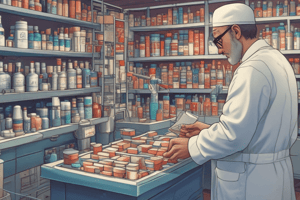Podcast
Questions and Answers
What is the primary function of tablet binders, and what characteristics do they possess?
What is the primary function of tablet binders, and what characteristics do they possess?
The primary function of tablet binders is to hold the tablet together and provide tablet strength. They possess strong binding properties, good compressibility, and are low cost.
What is the role of disintegrants in tablet formulation, and what properties do they exhibit?
What is the role of disintegrants in tablet formulation, and what properties do they exhibit?
The role of disintegrants is to facilitate the breakup of the tablet in the stomach. They exhibit high water uptake and swelling, and rapid dissolution and disintegration.
What is the purpose of fillers in tablet formulation, and what characteristics do they possess?
What is the purpose of fillers in tablet formulation, and what characteristics do they possess?
The purpose of fillers is to increase the bulk of the tablet and make it easier to compress. They are inert and non-reactive, low cost, and have high compressibility.
What is the function of lubricants in tablet formulation, and what properties do they possess?
What is the function of lubricants in tablet formulation, and what properties do they possess?
What is the primary function of coatings in tablet formulation, and what characteristics do they possess?
What is the primary function of coatings in tablet formulation, and what characteristics do they possess?
How do the characteristics of tablet binders and disintegrants differ, and what are the implications for tablet formulation?
How do the characteristics of tablet binders and disintegrants differ, and what are the implications for tablet formulation?
Flashcards are hidden until you start studying
Study Notes
Tablet Binders
- Function: Hold the tablet together and provide tablet strength
- Examples:
- Starches (e.g., corn starch, potato starch)
- Celluloses (e.g., microcrystalline cellulose)
- Sugars (e.g., sucrose, lactose)
- Polymeric binders (e.g., polyvinylpyrrolidone, polyethylene glycol)
- Characteristics:
- Strong binding properties
- Good compressibility
- Low cost
Disintegrants
- Function: Facilitate the breakup of the tablet in the stomach
- Examples:
- Starches (e.g., corn starch, potato starch)
- Clays (e.g., kaolin, bentonite)
- Cross-linked polyvinylpyrrolidone (crospovidone)
- Sodium starch glycolate
- Characteristics:
- High water uptake and swelling
- Rapid dissolution and disintegration
Fillers
- Function: Increase the bulk of the tablet and make it easier to compress
- Examples:
- Sugars (e.g., sucrose, lactose)
- Starches (e.g., corn starch, potato starch)
- Calcium carbonate
- Talc
- Characteristics:
- Inert and non-reactive
- Low cost
- High compressibility
Lubricants
- Function: Reduce friction between the tablet and the die walls during compression
- Examples:
- Magnesium stearate
- Calcium stearate
- Stearic acid
- Glycerin
- Characteristics:
- Slippery and hydrophobic
- Prevent sticking and wear on the tablet press
Coatings
- Function: Control the release of the active pharmaceutical ingredient (API) and provide additional functionality
- Examples:
- Film coatings (e.g., HPMC, HPC, PVA)
- Sugar coatings
- Enteric coatings (e.g., Eudragit, cellulose acetate phthalate)
- Lipid coatings
- Characteristics:
- Can be used to control release rate, target specific release sites, or provide additional functionality (e.g., taste masking, moisture protection)
Studying That Suits You
Use AI to generate personalized quizzes and flashcards to suit your learning preferences.




